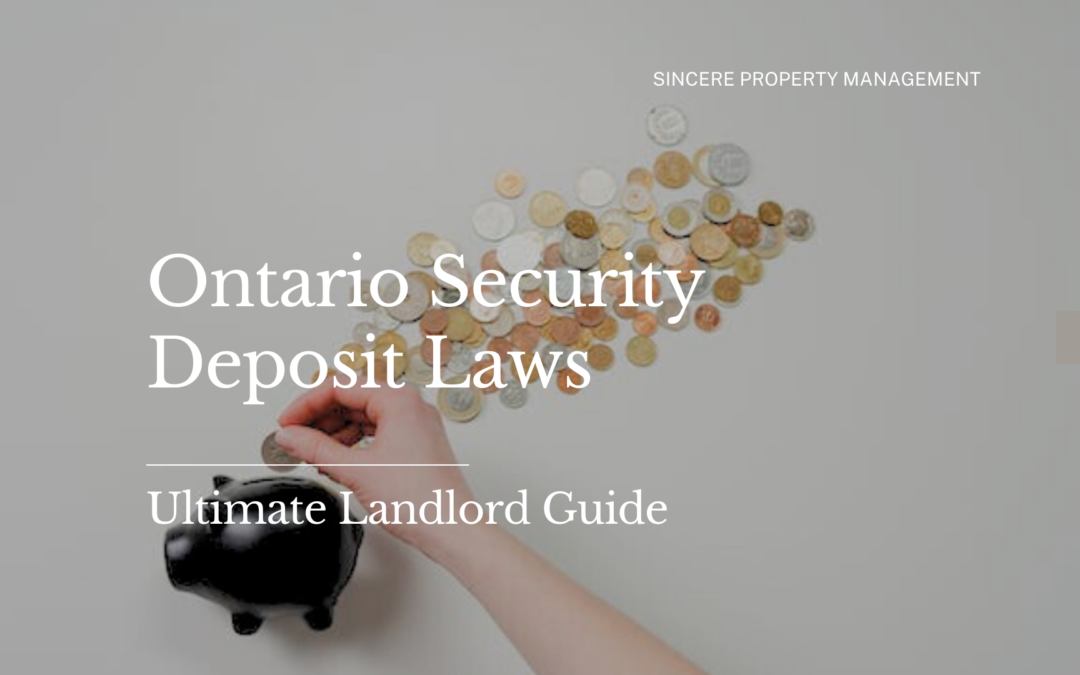Are you a landlord in Ontario wondering about security deposit laws and how they work? You’re not alone! Understanding these regulations is crucial for a smooth and lawful rental process.
In this article, we’ll demystify Ontario’s security deposit laws, offering clear and concise guidance tailored specifically for landlords. Whether you’re a seasoned property owner or new to the rental market, this guide will equip you with the essential knowledge needed to navigate these laws confidently.
Stay informed, stay compliant, and let’s dive into the world of Ontario’s rental regulations together!
Guide to Ontario’s Security Deposit Law
Here’s a comprehensive guide to help you navigate all the essential rules and regulations of Ontario’s security deposit law with ease.
1. Ontario Security Deposit Limit
In Ontario, the amount of a rental deposit is limited to the equivalent of the first and last month’s rent. This is different from a traditional security deposit, which is often used to cover damages.
The primary purpose of this deposit is to ensure the payment of the last month’s rent, not to account for potential damages or neglect by the tenant. The deposit must be collected at or before the beginning of the lease agreement, ensuring both parties have financial security and clarity from the start of the tenancy.
2. Nonrefundable Fees
Ontario’s regulations strictly prohibit landlords from retaining any part of the rent deposit for reasons other than covering the last month’s rent. This means that any damages or cleaning costs incurred during the tenancy cannot be deducted from this deposit.

This law protects tenants from unfair deductions and ensures that the deposit is solely used for its intended purpose. Landlords must find alternative means to cover these costs, separate from the rent deposit.
3. Storing a Tenants Deposit in Ontario
Landlords in Ontario are obligated to pay interest on the rent deposits they hold. This interest is calculated annually based on the province’s rent increase guideline and must be paid to the tenant every 12 months.
The interest rate is designed to compensate tenants for the time their money is held without being used. If a landlord fails to pay this interest, tenants have the right to deduct the owed amount from future rent payments or seek a rebate, ensuring fair treatment and financial transparency.
4. Written Notice after Security Deposit Receipt
Providing receipts for rent deposits is a mandatory requirement for Ontario landlords. These receipts serve as proof of the transaction and offer security to both parties.
The rent deposit, being a pre-payment for the last month’s rent, falls under the category of rent payments, hence the necessity for a receipt. This practice promotes good landlord-tenant relationships by maintaining clear and transparent financial records.
5. Reasons to Withhold a Tenant’s Security Deposit in Ontario
The only permissible use of a rent deposit in Ontario is for the payment of the last month’s rent. Landlords are not allowed to use this deposit for repairing damages caused by the tenant or any other purpose.

If landlords need to recover costs for damages or other liabilities, they must do so independently of the rent deposit. This regulation safeguards tenants from potential misuse of their deposit and ensures that landlords adhere to fair practices.
6. A Walk-Through Inspection
Conducting a walk-through or move-out inspection is a crucial step for Ontario landlords. This inspection, which can happen on the day of the tenant’s departure or within a few days after, allows landlords to assess the condition of the property and identify any damages beyond normal wear and tear.
The goal is to document the state of the property accurately to determine if there are any damages that need addressing, which are separate from the rent deposit. This process promotes fairness and accountability, ensuring that any claims for damages are based on concrete evidence.
7. Security Deposit Refund in Ontario
Typically, the security deposit is used to cover the last month’s rent. However, if it is not used for this purpose, landlords are required to return the full amount to the tenant within 30 days of their move-out.

This time frame ensures that tenants are not unduly deprived of their funds. In the case of a key deposit, it must strictly be used for the cost of replacing lost keys and should not exceed a reasonable amount. This protects tenants from excessive charges and ensures that deposits are used appropriately.
8. Change in Property Ownership
Typically, the new owner assumes the responsibilities of the previous landlord, including the handling of existing rent deposits. Both parties should ensure a smooth transition by updating all relevant records and documents to ensure that the new landlord is aware of and agrees to the terms of the existing deposits.
Conclusion
Navigating Ontario’s security deposit laws can feel daunting, but armed with this knowledge, you’re well on your way to a smoother landlord-tenant relationship. Remember, staying informed and compliant with these and other laws like those on the eviction process and lease termination is key to a positive rental experience. If you’re feeling overwhelmed, don’t hesitate to reach out to the experts at Sincere Property Management.
Our team is dedicated to simplifying property management for you, ensuring peace of mind and professional handling of all your rental needs. Let Sincere Property Management be your trusted partner in navigating the complexities of property management.
Disclaimer: This blog should not be used as a substitute for legal advice from a licensed attorney in your state. Laws frequently change, and this post might not be updated at the time of your reading. Please contact us for any questions you have in regards to this content or any other aspect of your property management needs.

